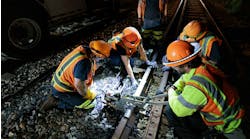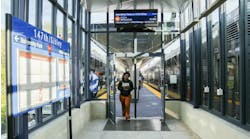Denver RTD MOW employees replace more than 2,500 feet of rail on Southeast Corridor
The Denver Regional Transportation District (RTD) Maintenance of Way (MOW) employees have replaced more than 2,500 feet of rail on the Southeast Corridor since June 4, resulting from inspections identifying rail defects.
“That’s significant in that [Denver] RTD rail workers typically replace rail 40 to 80 feet at a time,” said Dennis Hanson, Denver RTD Light Rail MOW manager, who added that MOW crews generally can replace 300 to 400 feet of 40- to 80-foot individual pieces of rail comfortably in a single area.
The Denver RTD MOW employees will continue into other sections of rail on the Southeast Corridor and beyond. RTD’s MOW team performs work overnight to enable services on the D, E, H and R light-rail lines to continue – even if at slower speeds than normal for limited sections – in consideration of the community and customers who rely on Denver RTD transit services.
Denver RTD says that due to the scope of rail replacement and maintenance needed, the project would usually be outsourced to a third-party contractor. Instead, the MOW team jumped in to perform inspections, maintenance and rail replacement.
“It was quicker to procure everything ourselves,” said Brian Farris, Denver RTD’s general superintendent of infrastructure.
The work along the Southeast Rail Corridor supports Denver RTD’s Back to Basics initiative to maintain all the agency’s assets in a state of good repair.
“Fortunately, we had enough rail in stock that we didn’t need to purchase more rail when we started the project,” Farris said, while noting that since then, the agency has added 10,000 feet of rail to its inventory for ongoing and future installations.
Hanson commended the MOW team for their work on the ongoing project.
“They’ve really risen to the occasion. They’ve been able to leverage their knowledge, skills and abilities. What’s impressed me is how they’re able to problem solve and come to a collective agreement on how to mitigate hazards and do the work safely. Everyone is getting the work done and they’re getting home safe and that’s the most important thing,” Hanson said.
Denver RTD Signal/traction Power Maintainer Chris White saysid working the night shift enables the team to make a difference for customers in restoring the rail.
“You have to work when the trains don’t run,” White said. “You can’t get out there with the trucks and equipment – that has to be at night when you can make major repairs.”
Denver RTD MOW third-shift employees work during a regular maintenance window from 9:30 p.m. to 6:00 a.m., with many MOW employees working extended 12-hour shifts, Sunday-Thursday. Maintenance is paused Friday and Saturday for Denver RTD to offer extended service to customers those nights.
“That works well because it’d be almost impossible to sustain that level of production seven days a week,” Hanson said.
The MOW crew comprises a track team, signal traction/power maintainers, track maintainers, track maintainer equipment operators, rail laborers and MOW supervisors, with approximately 75 people, including several contracted workers, to perform grinding to smooth out rail defects. Overnights peak with 22 people performing the work. Each third shift begins with hauling necessary equipment and materials to the work sites. Before that can happen, MOW employees start with heavy lifting.
“There’s a lot we do in the background to set up one night’s worth of work,” MOW Supervisor Raymond Ferreris said. “We unload all the trucks of rail that come in and we need to be strategic – it’s a skill to unload rail. We do small areas of rail replacement normally – this is the most we’ve ever done.”
“You don’t realize how long an [80-foot rail] stick is. I’ve moved a million of them and it still blows me away when I’m standing next to one,” said Denver RTD Maintenance Supervisor Evan Martinez.
Denver RTD notes that getting equipment to the worksite involves setting new rail on carts that travel on hy-rail capable vehicles – a slow manual process. MOW crews must also take caution while the new rail is in transit for installation.
“It doesn’t make contact with any other infrastructure in the guideway,” Hanson said. “There are a lot of safety protocols involved that we follow to protect our workers and they take time. It’s a very long process to get the materials out to where they’re needed.”
Denver RTD says many MOW team members say the finite period of working overnight is a challenge.
“It goes back into planning and making sure that we’re getting what we need in one load as opposed to two loads so that we don’t have two nights where it seems like you’re doing nothing but you’re doing a huge part of it,” Martinez said.
“In a six- or seven-hour window, there’s a lot of work on the front end and back end that has to be done before we can start pulling clips, pulling rail and replacing it with new. Time is the big constraint,” Hanson said.
When the workday ends, Denver RTD says MOW crews remove heavy equipment and materials and take them to their holding areas – and start the process all over again the next day, hauling materials back to the site.
“You have to clean up and get the equipment off the rails, making sure everything is ready for service when the rail resumes operations in the morning,” Hanson said.
As of early September, Denver RTD notes work on repairing rail on the Southeast Corridor is about 85 percent complete and MOW crews will be working to make repairs on other sections of Denver RTD’s system before the weather brings colder temperatures. Rail contracts during cooler weather, making the fall and winter season less conducive for installing new rail.
Grinding – a technique that can take off thousandths of an inch to smooth the track – is one solution to continue performing rail maintenance during cooler months. Farris says Denver RTD has been performing some profile grinding with a handheld machine and historically used this tool for maintenance in late winter months like February and March.
Denver RTD says that not only have MOW crews made a positive impact for the longer-term investment in rail services, but they have also acquired some new skills.
“You may have not gotten this on-the-job experience if you were here 10 years ago,” Farris said. “It’s invaluable in that’s how you learn to do rail.”
Project planning throughout remains key to maintaining safety on the job.
“All of us have stepped up. This team is really crushing it,” Martinez said. “I’m a track person by trade. I’ve done this forever and these guys make me better. It’s a team effort.”



